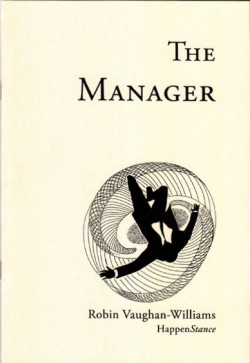Listen to ‘Risk Assessment Exercise’, ‘Fired!’, and ‘Follow the Leader’ from my Manager collection on the Spoken Word Antics Sound Archive. If you get asked for a username and password, you’ll find them in a panel on the right-hand side of the Sound Archive page.
Three new recordings of Manager poems now available
May 11th, 2010Waterboarding, as practised by the Inquisition
May 8th, 2010I was surprised to learn recently that waterboarding, designated an ‘enhanced interrogation technique’ by the Bush administration, was used by the Spanish and Portuguese Inquisitions. In fact, it was one of their two main forms of torture.
This is what Toby Green says in his book, Inquisition: The Reign of Fear (2007): ‘There were two main instruments of torture – pulleys and water’, but the ‘use of water was more common’.
The prisoner was placed on a potro, a trestle table, with the head lower than the feet, the throat and forehead held fast by a metal strap. The limbs were tied to the potro with ropes which bit into the flesh while others were twisted around them like tourniquets. The mouth was then forced open and water poured down the prisoner’s throat. Unable to breathe because of the water in their throats and with their bellies horribly bloated, their victims gasped for life as the inquisitors patiently admonished them to tell the ‘truth’. (p.71)
Now that sounds to me incredibly like the descriptions I have read of waterboarding, as practised (formerly, we are told) by the CIA.
Not exactly the same, but then there are different methods of waterboarding. The method used by the CIA, for example, is not exactly the same as the method used in the US Navy’s Survival, Evasion, Resistance and Escape (SERE) school in California, or the definition given by the US Department of Justice (http://waterboarding.org/official_procedure).
There are different variations on waterboarding, but in general – including both the Inquisitorial and CIA variants – they share several common characteristics:
- the victim is placed face-up on a tilted board, with their head at the lower end;
- water is poured into the victim’s mouth or nose;
- this creates a sensation of drowning in the victim, whose upper respiratory tract is filled with water, and who could actually asphyxiate if the procedure were carried on long enough.
What struck me was that I’d never noticed any mention of the connection with the Inquisition when following the debate in recent years about CIA waterboarding. You’d have thought this would have been a key point for opponents of waterboarding.
The Inquisition, rather like Nazism and racism, is widely regarded as being beyond the pale in our society, so awareness that waterboarding was a standard torture technique used by the Inquisition could potentially have had a significant impact on public perception. To claim that waterboarding was not a form of torture would be a bit like saying, ‘Spanish Inquisition not so bad after all!’.
I’ve done a bit of Googling, and, in fact, the connection was mentioned, but not a lot. The New York Times pointed out in April 2009 that
top officials […] did not learn that waterboarding had been prosecuted by the United States in war-crimes trials after World War II and was a well-documented favorite of despotic governments since the Spanish Inquisition; one waterboard used under Pol Pot was even on display at the genocide museum in Cambodia. (http://www.nytimes.com/2009/04/22/us/politics/22detain.html)
However, as John McQuaid argues in The Guardian, much of the US press, including the New York Times, often stood on the fence by using euphemisms like ‘harsh’ or ‘brutal’ interrogation, rather than coming clean with the word ‘torture’ (http://www.guardian.co.uk/commentisfree/cifamerica/2009/may/12/torture-new-york-times-washington-post).
Further reference
- waterboarding.org, an excellent resource on the subject, with first-hand accounts, information on the technique, and arguments about its status as torture.
- A short sketch of the history of waterboarding from National Public Radio.
- A Question of Torture: CIA Interrogation from the Cold War to the War on Terror, by Alfred W McCoy (2006), includes an account of the evolution of torture techniques since the Inquisition.
Posted in zqblog by Robin Vaughan-Williams, 28 April 2010.
No. 163 (Morden to Raynes Park)
April 30th, 2010I spilled a cup of water on my social wor-kaah, but most of it went all over his mana-gaah.
He was going to tell me what happened, but you know what the first thing he says is, ‘well I’m not saying anything till you’ve made me a cup of coffee’.
NOT SAYING ANYTHING TILL YOU’VE MADE ME A CUP OF COFFEE
I couldn’t believe it.
MAKE IT YERSELF THIS IS MY MEETING AND YOU CAN’T ORDER ME ABOUT LIKE A FUCKING SERVANT
Then he sort of smiles and says he was only winding me up, but a coffee would be nice. I say this is my meeting and you’re here to tell me what happened, not sit and drink coffee.
That’s when I spilled a cup of water on my social wor-kaah, but most of it went all over his mana-gaah.
This is what I have heard
April 27th, 2010I have heard that in Sri Lanka the new president, who just a few months ago was widely criticised for being young and inexperienced, is proving his worth. He has installed his two brothers in the ministries, which some would label as nepotism, but you have to have people you can trust. The war is over. Gone are the charges of genocide. Sri Lanka is now a peaceful nation. And already you can see the change. He is bringing in Chinese money to repair the roads, upgrade the ports, and fix infrastructure that has not been touched in decades. The country is opening up. People from the south are flooding the north. Tourists are coming. They want to see this beautiful land that has been closed for twenty-five years. People are saying it is a good thing. This is what I have heard.
Sphinx poetry reviews
April 11th, 2010Four new reviews of recent poetry pamphlets in Sphinx 12:
- Peter Sansom, The Night Is Young (Rialto, 2009)
- Andrew McMillan, Every Salt Advance (Red Squirrel Press, 2009)
- Lyn Moir, Easterly Force 10 (Calder Wood Press, 2009)
- Michael Davenport, Tell Me about Them (Tyne and Esk Writers, 2009)
Sphinx reviews focus on poetry pamphlets (also known as chapbooks), and has hit upon the brilliant idea of commissioning three reviews for every pamphlet featured, so you get two other perspectives on each of these books alongside my own. There are also plenty of other reviews to browse.
Volcano Trip (Fimmvörðuháls)
April 5th, 2010Last week two of us decided to go and see the volcano at Fimmvörðuháls in southern Iceland before it was too late. It began erupting around 21 March, and on Thursday last week reports were coming in that it was beginning to die down. But then that same evening a new fissure opened up, renewing the flow of lava.
Now the walk from Skógafoss up to Fimmvörðuháls and down the other side into the lush and wonderful valley of Þórsmörk is one that I’ve been wanting to do ever since I visited Þórsmörk last summer, but it’s not a walk you would ordinarily do at the start of April. Fimmvörðuháls is a watershed lying over 1000m up in between two glaciers, Eyjafjallajökull and Mýrdalsjökull. The weather can be very changeable, large sections of the route are liable to be snowed over, and it can be bitterly cold. I have heard that it has reached -30C up there in the last couple of weeks, and that several walkers have come down with hypothermia.
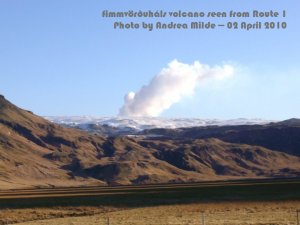
Fimmvörðuháls eruption seen from Route 1
It was cold. The roadside thermometers en route read -9C and I had to wear two woolly hats and a hood to keep my head warm. Without the hood, the wind just blasted through. I felt like an Arctic explorer, with just a small patch of skin exposed around the nose, which ended up getting super chilled and sunburnt at the same time.
The walk began at Skógafoss, an impressive waterfall known for its perma-rainbow (so long as the sun is shining). In the summer I’d tried to get as close to the rainbow as I could; the closer I had got, the more the rainbow had shrunk, until its arc had become a full circle just a metre or two from my hands. At that proximity to the falls, you feel like you’re being battered by shock waves as the force of water slamming into the pool at the bottom sends pulses of spray and water radiating outwards.
I got drenched, of course, but that was the summer. This time we made straight for the steps up beside the waterfall, which are a good warm-up for the walk to come. Above Skógafoss, the path climbs continuously but gently, following the river Skógá as it runs through ravines, around rocky outcrops, and over dozens of waterfalls. Several times the path splits, but the branches always re-join, so you can’t go wrong. The left branches usually pass closer to the river—more picturesque, but sometimes also involving precipitous scrambles.
In spite of the cold, the sun was bright and the sky absolutely clear, so we had fantastic views looking back down the mountainside towards the ocean, with flat farmlands and black sands in between. The river was often marked by a dark gash of canyon, and on the right the massive but diminishing pyramid shape of Raufarfell showed how far we had come.
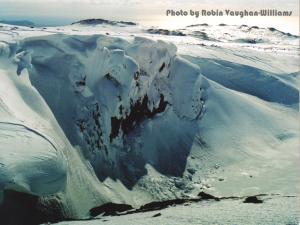
snowboard heaven
Many of the waterfalls were frozen over, and overhangs in the canyon walls were dashed with giant icicles. Smoothly formed features in the upper rock strata that must have been formed by fluvial erosion gave us a sense of geological change, how the river must once have flowed much higher up in the canyon.
The river itself was frozen over in many places, with dark channels where the water still flowed freely marking the thalweg, the place where the current is strongest. Sometimes the shapes formed by the ice seemed to pick up the spiralling patterns of eddies, especially at turns and narrow points, and once or twice I spotted what looked like fast-forming ox-bow lakes, where the water must have been blocked off, only to push through another course.
After three hours or so, at about 550m, we came to the snowline, where it might ordinarily have become much harder to navigate, but because so many people had already hiked to see the volcano before us, all we had to do was follow the footprints. Every now and then we got overtaken by other walkers, who all seemed to know exactly where they were going, so by watching their progress we could see where the path was leading.
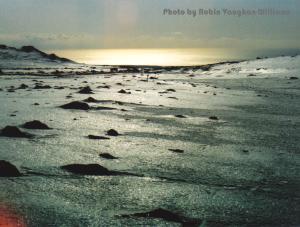
monster eggs hatching through the snow
Up in the snowfields, the landscape took on a completely different appearance. The incline became gentler around this point, and we were high enough to see far into the distance, over the rolling tops of hills. Sometimes black rocks broke through the snow, like monster eggs hatching after a winter’s gestation. Beneath the sun, the snow shone fiercely bright, and beyond we could still make out the wide strip of beach and the sea, which had turned orange near the horizon.
This was, however, the hardest part of the ascent. The plume of smoke issuing from the volcano seemed much closer now, and we kept thinking it was just beyond the next ridge, only to discover yet another plane to traverse. We were also getting pretty tired, and began to begrudge the helicopters that buzzed back and forth overhead every half an hour.
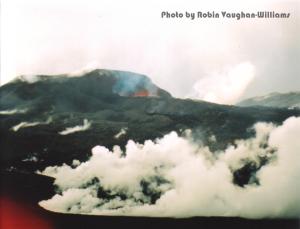
Fimmvörðuháls eruption site
Finally, after six hours, we made it. For a while the snow had been speckled with grey—fallout from the eruption—and within about a one-kilometre radius of the site the snow was covered with a light black ash. I let out a yell when I caught sight of something red streaming intermittently over the edge of a slope, thinking it was lava, but it turned out to be the ribbon of a safety barrier.
There was a black triangular hill ahead of us (which I take to be a peak marked as 1093m on the map) and a mound to the right of it which people were using as a viewing platform. Walkers, skidoos, quad bikes, and jeeps were congregating at this point, and a helicopter was on stand-by nearby.

splash of lava
From the mound we could see a plane below us with the fresh lava flow spread out across it. It had already cooled enough to turn black and didn’t seem to be moving, but there were huge clouds of vapour rising out of it, and a sense of constant activity, with little bursts and hisses and spouts of steam going on in the background. Having walked across plenty of old lava fields, with their jagged shapes, random protrusions, and tectonic cracks and folds, I could well imagine the furious metamorphosis that was going on inside.
Behind the lava flow was a ridge (probably Brattafönn, 1053m), and beyond this splashes of red lava were constantly being thrown up into the air, as if Jackson Pollock were hard at work on his latest creation. Except that artists like Pollock usually built up with painstaking care the impression of spontaneity, whereas here the emissions were genuinely chaotic, channelled only by the underlying regularity of natural processes.
I have seen some spectacular images of lavafalls, which must have been taken the other side of the ridge, where the lava drops into the steep-sided Hrúnagil valley, but we weren’t able to explore the eruption site any more, as we needed to get back to Skógafoss before nightfall. As a parting shot, once we had turned our backs to the volcano we were bombarded with a shower of volcanic grit, which drummed on our coats like hail.
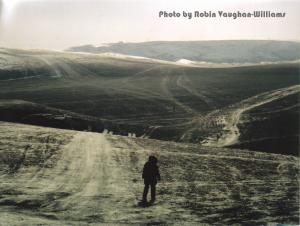
looking back
The descent was difficult, and took five hours, almost as long as the ascent. Clouds started rolling in while we were at the top, bringing fresh snow with them, and the snowfields we had to cross seemed to have become much more icy than on the way up, so that we both slipped over about 20 times and had to resort to taking tiny steps in order to avoid falling. We also both developed bad knees, so that even once we were below the snowline we pretty much had to hobble down the mountainside.
Twelve hours after setting out, we reached the car. It was 9.20pm, and within half an hour it was pitch black, with whatever moon there might have been obscured by the clouds. The peculiar thing was that on our way down we passed hordes of people walking up, even when we were halfway down. They seemed to think nothing of marching up a mountain with hours ahead of them, snow, ice, wind, sub-zero temperatures, and darkness descending, their only plan—to see how the earth had opened up.
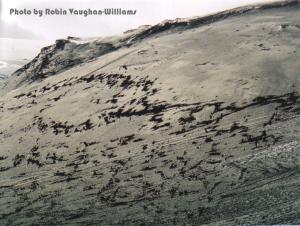
patchy snow
Materials
- Find out about the weather at Fimmvörðuháls on this Danish weather site.
- 3D fly-through of the eruption area. This is the best way of getting an impression of the lie of the land I have found so far, although it misses out all the snow. Blue dots are cabins, and the fissures are in red.
- Video of a lavafall here, and some pretty nice footage of the eruption from Morgunblaðið here (listen out for the sounds…not just the music!).
- A couple of descriptions of the walk from Skógafoss to Þórsmörk can be found here (Bergverlag Rother) and here (Walk: The Magazine of the Ramblers). Bear in mind, though, that these are aimed at summer walks, not winter walks.
Posted in zqblog by Robin Vaughan-Williams, 5 April 2010.
Two Poetry and Music Performances: ‘Bat Detector’ and ‘Somewhere to Get to’
November 13th, 2009At the Off the Shelf Festival in Sheffield this year, Signposts organised a couple of poetry and music events, featuring a mixture of newly commissioned work and restagings of work from recent years.
This is a review of the first of these nights, 20 October 2009, which featured ‘Bat Detector’ by Elizabeth Barrett (words) and Robin Ireland (viola), and ‘Somewhere to Get to’ by Shelley Roche-Jacques (words) and The Only Michael (electronic sounds).
As will become obvious when you read the article below, I’m more interested in exploring how the poetry and music work together in performance here than in either the poetry or music on their own.
*
I first heard ‘Bat Detector’ on CD in 2007, when I played it on my radio show, but this was the first time I had heard it live. Then, as now, I felt there was something terribly restrained and even forced about the arrangement: the way that the viola and voice do not overlap at all, but are purely sequential. While part of me doesn’t like this very much, in the end I find it a powerful and moving piece, and full of tension, which is in part generated by the forced nature of its restraint.
The viola and the voice in ‘Bat Detector’ are not so much brought together, as forced to exist side-by-side, each enduring the other’s company, one waiting politely for the other to finish before taking its turn, then yielding again to the other. The form is stiff and Victorian, like a duet where the partners do not dance together, but instead take it in turns to dance, each waiting and watching while the other plays their part.
The text of ‘Bat Detector’ deals with blockages in communication. There is an autistic child, a difficult relationship, and the image of the bat detector itself, a box that allows us to listen in on the calls of other creatures we cannot understand, to hear sounds that we would normally be oblivious to. There is a sense that the worlds of other creatures, not just bats but also other human beings, are strange and obscure to us, and we can only listen in with wonder and curiousity. The bat detector, the medium of communication, is an instrument of delicacy, and there is something miraculous about it when it works.
The voice and the viola are rather like this. Two individuals, two different species, two different languages. The viola playing is precocious, irritating even in its desire to display its technical inventiveness and virtuosity. It scuffles about, seems to pick up on a rhythm, but then runs with it only intermittently, as if poor reception were causing it to cut out. You don’t feel the rhythm, but you feel like there is something else that does. And all this, somehow, seems to bear on the voice and its poetic content: there is the fluttering and screech of bats, the sense of a multitude of creatures, a fractured cloud of sounds that cannot be grasped individually, but which nevertheless impresses its mass upon you, and the rhythms of speech that somehow find their way into the music.
So, in holding apart words and music, as if to say, look, these are so different they could not possibly get on together, the poet and the violist actually allow the affinities between the two protagonists to emerge, and it is as if they would slam back into each other, were they not held apart with such force.
*
Perhaps one of the reasons for separating text and music in ‘Bat Detector’ was that each behaves as a soloist, demanding the full attention of the audience. They are two soloists without an orchestra. In ‘Somewhere to Get to’ this relationship is less clear. To begin with the music was extremely quiet, as if afraid of interfering with the voice and unsure of its own place in the performance. But then the volume surged, as if suddenly untamed, and threatened to drown out the ensuing poetry. It stepped back again, allowing the voice to come to the fore; but, having demonstrated its power, however quiet and submissive it got, from now on there was always the threat that it might surge again and overwhelm the voice. The music kept changing throughout, without any apparent continuity in rhythm or melody, and it was this unpredictability that I thought characterised it most.
In ‘Somewhere to Get to’ it was ultimately the words that held the piece together, the train of thought that holds its own against the concatentation of sounds swirling around it. The music, a mixture of samples, beats, and looped guitar, functioned more as a constantly moving backdrop, a series of imaginings that brought out the less stable content underlying the consistency of poetic style and delivery. It was rather as if we were on a journey through an urban environment, moving from space to space, where the various rhythms of work, conversation, machinery, and so on, keep changing. When the volume was low it was as if we were listening behind a closed door; then the door would open and we’d get flung forwards into the roar of traffic or rattle of a drill, so you could barely catch the words or hear yourself think.
Pick your own bilberries…and beat the minimum wage!
September 5th, 2009When I set out to quantify in money terms the potential utility and remuneration for picking your own bilberries, I didn’t even expect to beat the minimum wage. I thought that picking your own bilberries would turn out to be a brazen act of self-exploitation, and that any self-respecting homo economicus would choose to hire cheap migrant workers to undercut themselves, thus freeing up their own labour time up for more profitable ventures.
However, this afternoon two of us picked around 3,000 bilberries in just one hour (with the jet-engine roar of a geothermal power plant in the background). That’s marginally over 800g. If bilberries sell for around £3 per 150g in the shops, then according to my calculations we earned ourselves about £8 per hour of bilberry utility.
And then there’s the benefit of being out in the fresh air and striking yoga-type poses on the hillside as you try to balance on the slope while reaching for those low-lying berries. Lets say the exercise and suppleness value-equivalent is two hours of yoga sessions at £6 per hour – and I’ve no idea how you monetise fresh air – that brings the total quantifiable utility of our harvest to £28, or a very respectable £14 an hour.
Of course, I’ve not included transport and fuel costs, which can apparently have a considerable impact on bilberry prices (read a detailed analysis of the relationship between fuel prices and blueberry prices here).
day 3, Nýhil International Poetry Festival
August 23rd, 2009I sometimes get the feeling that geography plays a big role in the development of poetic style. I remember how in Sheffield, when we got people from other parts of the country in to perform at Spoken Word Antics, they often seemed like a breath of fresh air…not that it ever felt stale in Sheffield. That was the funny thing; you had a vibrant, diverse scene going on, and then someone would come along from outside and do something that was just self-evidently different from anything anyone in Sheffield would do. And that’s a bit what it was like at Friday’s poetry reading, day three of the Nýhil International Poetry Festival (Fimmta alþjóðlega ljóðahátíð Nýhils). There were ten poets, four of them from abroad, working broadly within what you might call the avant-garde tradition.
Dmitry Golynko, a Russian poet who is published in New York, read mainly in English, with a high-pitched incantatory tone that signalled a constant state of alarm. Even as he read in English his pronunciation (‘w’ as /v/, for example) and the melody of his voice seemed to transform many of the words back into Russian, so that the poems often had a liquid quality to them, melting back and forth between one language and the other. The repeatedly intoned line ‘weep it out’ in one poem sounded to my ears like the Russian ‘vypytaiut’, with its connotations of extortion and interrogation, and I struggled to remind myself that it was English. I can’t comment much on the content, but a lot of it seemed to address Kafkaesque (or Putinesque) state machinations, so this mis-hearing on my part wasn’t completely out of place.
UKON, a Swedish poet, used a lot of repeated sentence structures in his poems. One piece simply consisted of a long list of questions about ‘the father’, each question ending with the answer ‘nothing’.
What had the father bought for a Christmas present?
Nothing.
What did the father do for a living?
Nothing.
The effect of these accumulated negations of paternal responsibility, care, and agency was drastic, yet not entirely bleak, probably because there was an element of caricature implicit in the degree of exaggeration. The total rejection and alienation of the father seemed to reflect as much on the subject of the poem as on the father, suggesting that the inadequacies of the father have been passed on to the next generation. The lack of specification of who the father was and what the speaker’s relation to him was left the poem open, so that it could be interpreted at an intensely personal level or at an institutional level — the role, and implied failure, of fathers in society.
Another poem of UKON’s that impressed me was about age and height, and was largely made up lines of the type, ‘At the age of 8 I was 120cm. Two years later I had grown an incredible 34cm’. It went from birth right through to death at the age of 84, and clearly evoked those marks most families make on some spare wall or doorframe to chart the growing height of their children. All went as expected for the first three decades, with rapid growth through childhood and puberty levelling off. In the 40s the subject shrank slightly due to an illness — a bit earlier than one would expect, but still plausible. But from the 50s onwards the subject’s height departed from all norms, shrinking, then growing, then shrinking again to just half a centimetre, before doubling in size to one centimetre and increasing again by 1000%. In old age the subject’s height became extremely volatile, fluctuating from zero in one year to 34 metres in another.
The way that in late middle age the height took off, rather than shrinking, had a fantastic sense of elation to it, as if the subject had been emancipated from the rigours of aging. Perhaps this represents the emancipation of retirement or the loss of inhibition that some people feel around that age. The volatility during old age, on the other hand, evoked for me the uncertainty and physical insecurity of old age. I felt that height worked in the poem as a metaphor for the ego, or perhaps general confidence and wellbeing. Maybe the slight shrinkage in the 40s was the onset of a mid-life crisis.
In the second half we heard from two Danish poets, Mette Moestrup and Morten Søndergaard. Moestrup read a piece that drew on her time working in a hospital cafeteria when they were issued with skirts that were too short. The poem was all in Danish, but somehow it was very easy to follow, and the occurrence of words like ‘feminist’, ‘sexist’, and ‘communist’ gave non-Danish speakers a pretty good idea of what was going on. I even found myself laughing in places, although though I couldn’t have told you exactly what was being said.
Morten Søndergaard finished the evening with a piece in which he tried to incorporate the ‘noise’ that you get when you open a file on the computer in the wrong programme — that jumble of unintelligible characters, yielding occasionally to strings of recognizable text. I always feel like I am being confronted, and affronted, with something when I see this, like seeing a mess of DNA code with an ear and some body parts floating about in it. Søndergaard’s method of rendering this noise in performance was through using his Kaoss Pad — an effects and sampler box, as far as I can work out — to modulate, distort, and screw around with his voice. This seemed like a pretty good audio equivalent; the noise in a file is language and formatting distorted by a computer, and the noise produced through his Kaoss Pad was also language (his voice) distorted through a computer.
He also performed it perfectly, managing seamless transitions between direct speech and the sampled sections, which nicely balanced being irritating, intriguing, and just a little bit amusing. The effects even provided some relief at the end of the poem, which consists of a large block of text something like this: ‘abbaaabba ggapp gabba baahba…’. He started reading this and my heart sank, —oh no, are we going to have to sit through a whole paragraph of this?! Then, just as I was about to become paralysed with despair, he started comically modifying the sounds he was producing, giving the whole thing a playful twist.
It’s harder to say much about the Icelandic poets because, with the exception of one (Kári Páll Óskarsson, I think), they spoke and read exclusively in Icelandic, and I’ve already gone on enough (in my previous post) about the excitement of listening to and miscomprehending poetry in a language you understand little of. I recognised Kristín Svava Tómasdóttir’s piece from the Summer Poetry Jam in May. It contains the phrases ‘Mr Brown’, ‘I am not a terrorist’, and ‘viltu pylsu?’ (‘do you want a hot dog?’), which effectively convey the thrust of what I take to be an angry and witty poem. I missed the line about the hot dog this time, but she made up for it with double-bass accompaniment.
I did wonder whether, in the international spirit of the Festival, all poets ought to be required to perform at least one poem in a language other than their own. Most of the visiting poets read in three languages — their own, Icelandic, and English — and I was struck by how comfortable they seemed be with their poems in translation. Maybe that is something that poets in non-English languages have to live with a lot more — seeing their poems alive in different languages, and not thinking of translations as second best, but as another manifestation of the poem, another part of its life. It’s all part of the process of letting go, which happens the moment you publish or perform your work, but even more so when you let someone else render it into a different language for you.
fragmented thoughts and unexpected collisions (open mic at the Nýhil International Poetry Festival)
August 20th, 2009At last, some live poetry! The Nýhil International Poetry Festival is upon us, and yesterday was night one, the open mic/michelle. I hadn’t been to any live poetry events since May, and last night I realised how much I’ve been missing it.
I read about the event on the Nýhil blogspot, and worked out that it was one poem each (in spite of being an ‘international’ festival, there’s been very little information available in English about it), but hadn’t realised that you were also supposed to read one poem by someone else too. So when it came to my turn, just like on Who Wants to Be a Millionaire?, I decided to text a friend, and was able to read out this haiku by Matt Clegg, direct from Sheffield:
A lone cobweb hangs
from the campsite tap — supports
one obese droplet.
I think it’s from ‘Trig Points’, which you can listen to on the Spoken Word Antics Sound Archive.
I also read ‘Shelter’, a poem of mine about a woman in a strange land who can’t speak the language trying to find her way. It reminded me of how I feel myself here sometimes, although the big difference is I can always open my mouth and speak English, which the woman in the poem can’t.
The running order was anarchic in logic – people just got up to read when they felt like it – but not in style; maybe a certain ease comes from people choosing their own moment…although I did occasionally notice those with less self-awareness prevailing over those with more.
Some I could understand, some I couldn’t; there was an English translation, which we were assured was nothing like the original, a rather un-hip rap (the kind where the words are forced into a rhythm, rather than written with rhythm in them), a poem from the milk carton, one neurotic piece that reminded me of the landlady from hell we narrowly escaped committing to a few months ago, and an interminable tract of social theory (the spectator, media, hegemony…Baudrillard perhaps?) that had us all feeling much enlightened once it was finally over.
All those words, all those people with things to say; one glorious, eclectic jumble of articulation and, on my part, much miscomprehension (but serendipitously so). Here is a rough approximation of what’s going on in my head when I’m listening to poetry in Icelandic:
‘Hvað sem ég er, í bílinum, reyking í geymsla…smoking in the cellar, or is that an invoice, something about a car, and what is it that I am?’
As you can see, it doesn’t make a lot of sense, but there is something wonderful about the combination of images and words, the fragmented thoughts, and unexpected collisions. I’m often not very good at paying close attention to what I’m listening to anyway. If I’m really enjoying a piece of music or poetry, it’s often because it’s stimulating my thoughts; my mind may be somewhere completely different, though still working in parallel to the performance and in some way guided by its structure, its shifts and moods. Listening to something you can only fractionally understand could be seen as a liberating aesthetic experience, because it frees you from any obligation to pay close attention, while a residual structure comprised of tone of voice, rhythm, sound texture, intonation, and so on – everything that is left when you take away the words – keeps you connected.
